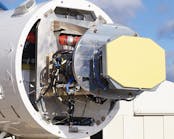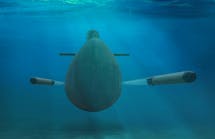Air Force, NASA to develop radiation-hardened ARM processor for next-generation space computing
GREENBELT, Md., 21 June 2016. U.S. government space researchers want industry to develop a next-generation radiation-hardened, general-purpose, multi-core processor within the next four years to meet on-board computing needs of future manned spacecraft and space robots.
Officials of the NASA Goddard Space Flight Center in Greenbelt, Md., issued the final solicitation Monday for the High Performance Spaceflight Computing (HPSC) Processor Chiplet program for NASA and U.S. Air Force manned and unmanned spacecraft.
This four-year project is expected to deliver a next-generation rad-hard space processor based on the ARM processor architecture to provide optimal power-to-performance for upgradeability, software availability, ease of use, and cost.
The HPSC project also will use Radiation Hard By Design (RHBD) standard cell libraries, as well as the ARM A53 processor with its internal NEON single instruction, multiple data (SIMD) design. Experts say a heterogeneous multi-core architectures using many different processor core types will not provide the best possible return on investment.
Related: Next-generation rad-hard space microprocessor to be defined by Air Force and NASA
Applications for the HPSC processor will include military surveillance and weapons systems, human-rated spacecraft, habitats and vehicles, and robotic science and exploration platforms. System applications range from small satellites to large flagship-class missions.
Space computing tasks of the HPSC processor will include command and data handling, guidance navigation and control, and communications like software-defined radio; human assist, data representation, and cloud computing; high-rate real-time sensor data processing; and autonomy and science processing.
The HPSC processor will include Serial RapidIO (SRIO) for high-bandwidth communications, and several interfaces to high-speed off-chip memory. The SRIO interfaces also can function as advanced microcontroller bus architecture (AMBA)-bus bridges to tile or cascade several processors to increase bandwidth or improve fault tolerance.
The SRIO interface also can extend the HPSC processor to other SRIO-enabled processing devices such as field-programmable gate arrays (FPGAs), graphics processing units (GPUs), and in the future to other application-specific integrated circuit (ASIC)-based coprocessors.
Related: FPGA development devices for radiation-hardened space applications introduced by Microsemi
Air Force and NASA experts have defined the ARM-based hardware and companion Linaro system software as the HPSC processor baseline architecture.
Today's radiation-hardened space processors typically are single-processor systems based on existing commercial or military computers. they operate at maximum required throughput, fault tolerance, and power levels. Air Force and NASA space experts, however, say they anticipate future missions that will require an increase in throughput and wider variations in throughput, fault tolerance, and power levels.
To do this they need a new space processor design that will provide orders of magnitude improvement in performance and performance-to-power ratio as well as the ability dynamically to set the power-throughput-fault tolerance operating point.
Related: Rad hard SPARC V8 processor that resists space radiation introduced by Atmel
Future onboard space computers for manned and unmanned missions will require big improvements in vision-based algorithms with real-time requirements; model-based reasoning techniques for autonomy; and high rate instrument data processing.
Air Force and NASA experts say industry can develop the HPSC processor with the available funding, using the COTS ARM A53 IP along with other COTS peripheral IP, that can meet performance, power, and radiation-tolerance needs.
This four-year project will consist of a preliminary design phase, a detailed design phase, a fabrication phase, and a test and characterization phase. The project should lead to a processor behavioral model, prototype processors, processor evaluation boards, and system software.
A key goal for the HPSC project is the ability to trade dynamically between processing throughput, power consumption, and fault tolerance. The HPSC processor architecture sometimes will be inside a dedicated spaceflight computer, and sometimes may be embedded in a science instrument or spaceflight subsystem.
Related: Rad-hard moves into the submicron age
The range of these applications can be from robotic science data processing to human rated applications employing ARINC-653 time space partitioning.
Fault tolerance management middleware will enable the processor to detect and log errors; remove services likely to experience hard failures; respond to uncorrectable errors; and implement n-modular redundancy, checkpoint/rollback, or other high-level fault tolerance.
Companies interested in bidding on the HPSC processor project should respond no later than 20 July 2016. Email questions or concerns to NASA's Denise Sydnor at [email protected].
More information is online at https://www.fbo.gov/notices/eefe806f639ae00527a13da6b73b3001.

John Keller | Editor
John Keller is editor-in-chief of Military & Aerospace Electronics magazine, which provides extensive coverage and analysis of enabling electronic and optoelectronic technologies in military, space, and commercial aviation applications. A member of the Military & Aerospace Electronics staff since the magazine's founding in 1989, Mr. Keller took over as chief editor in 1995.



